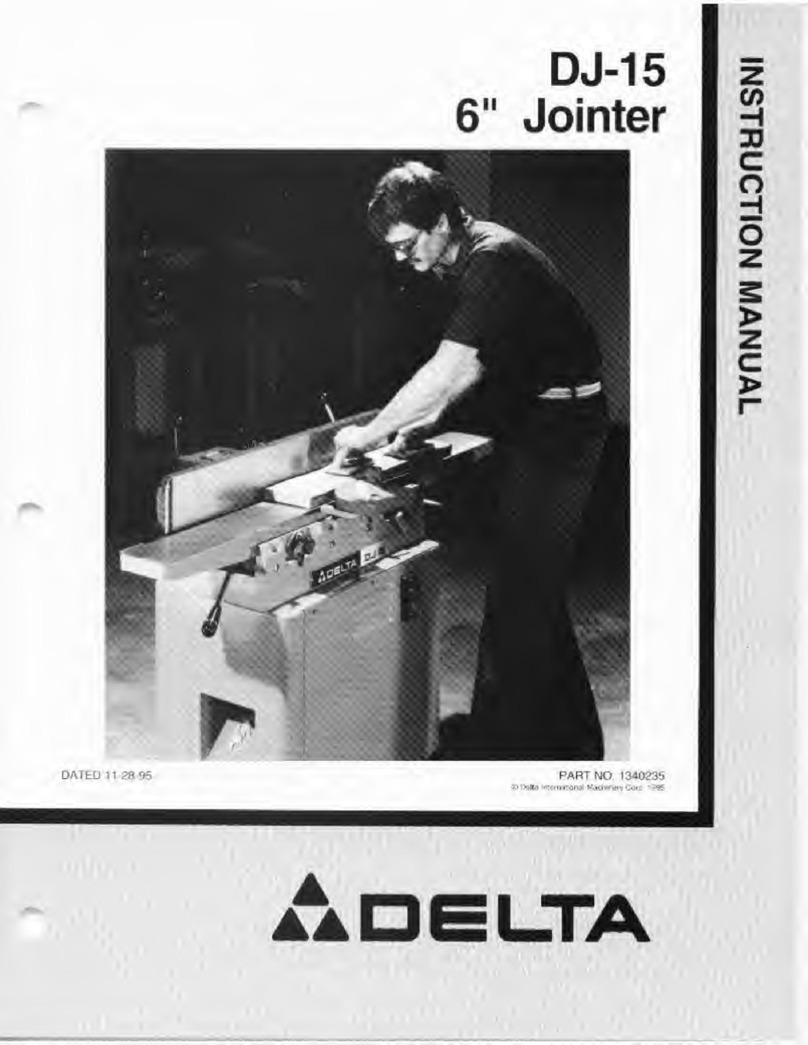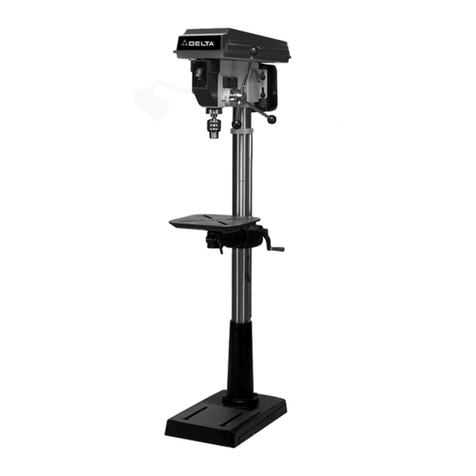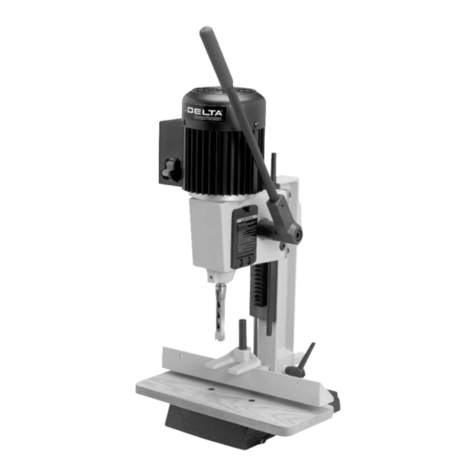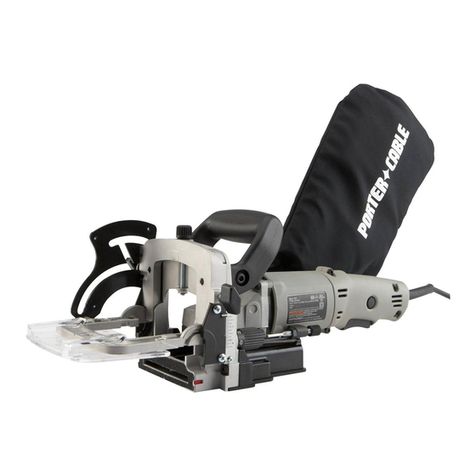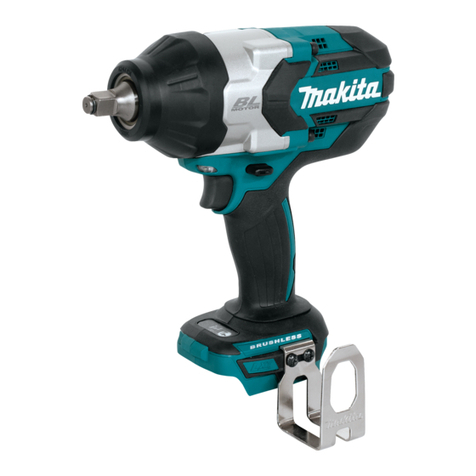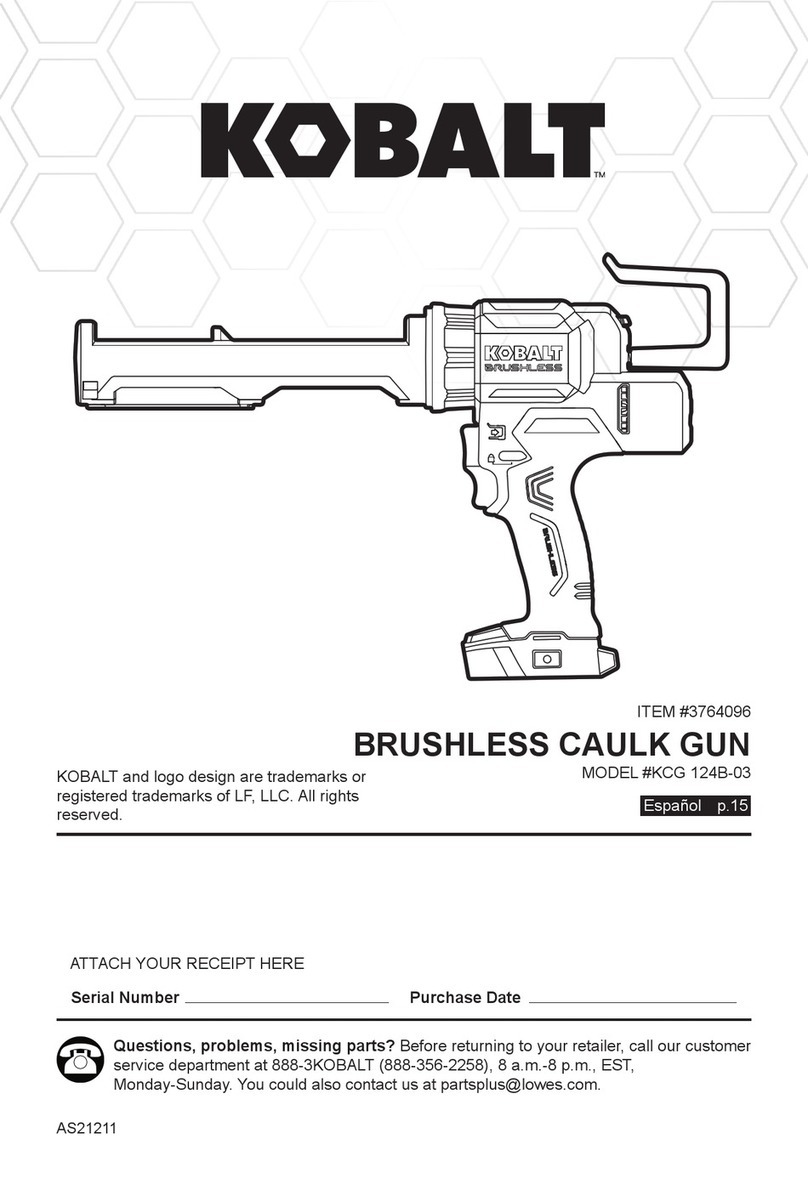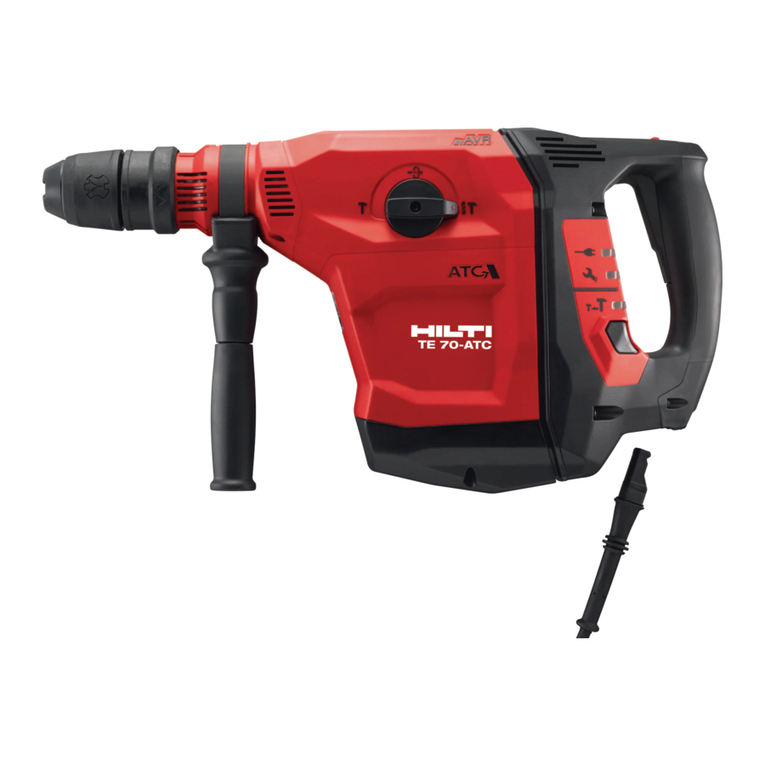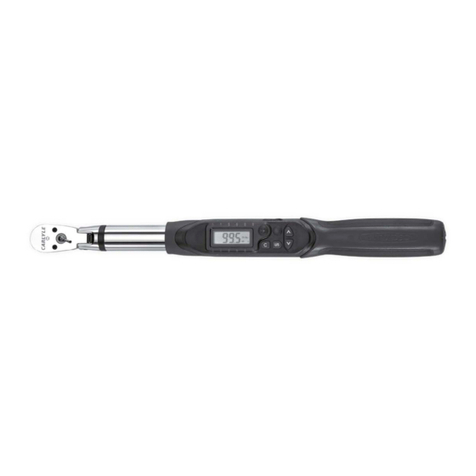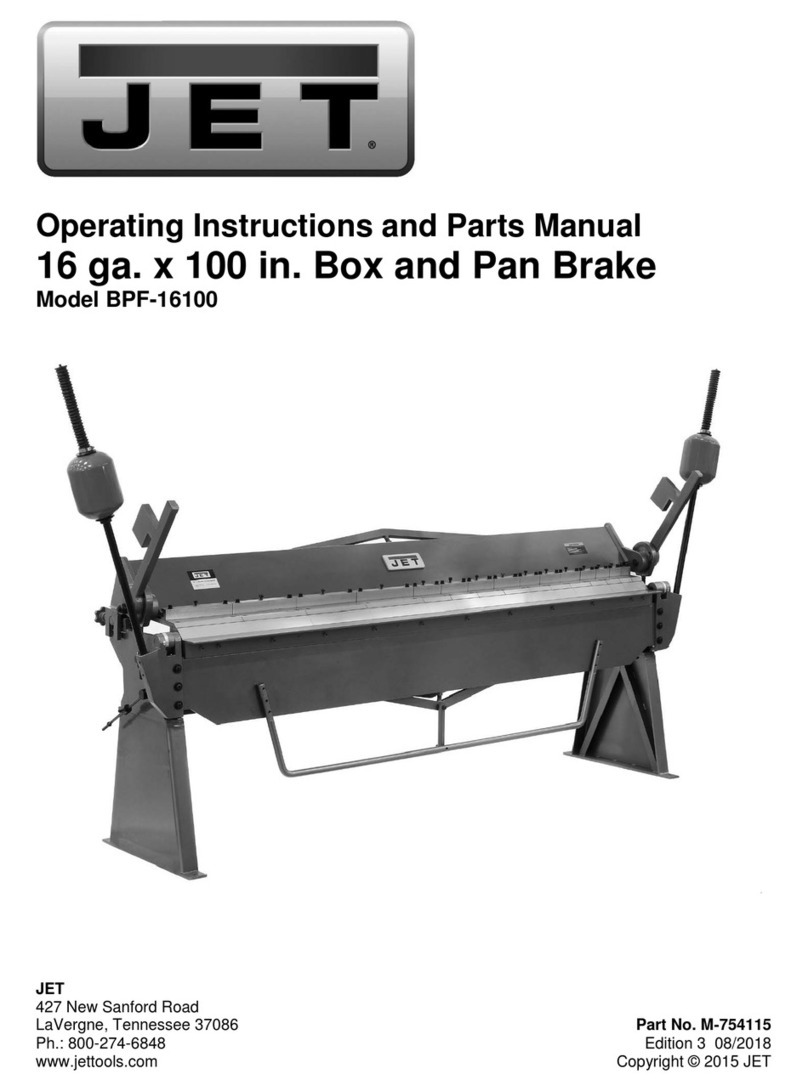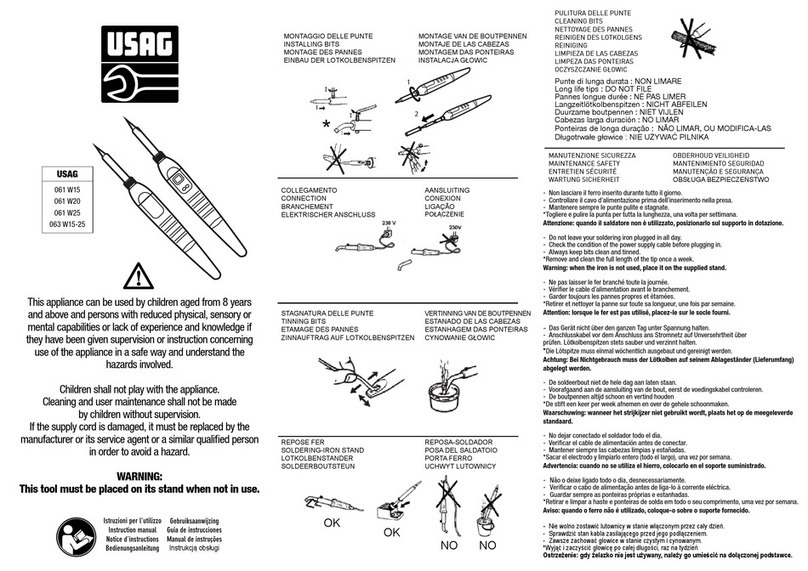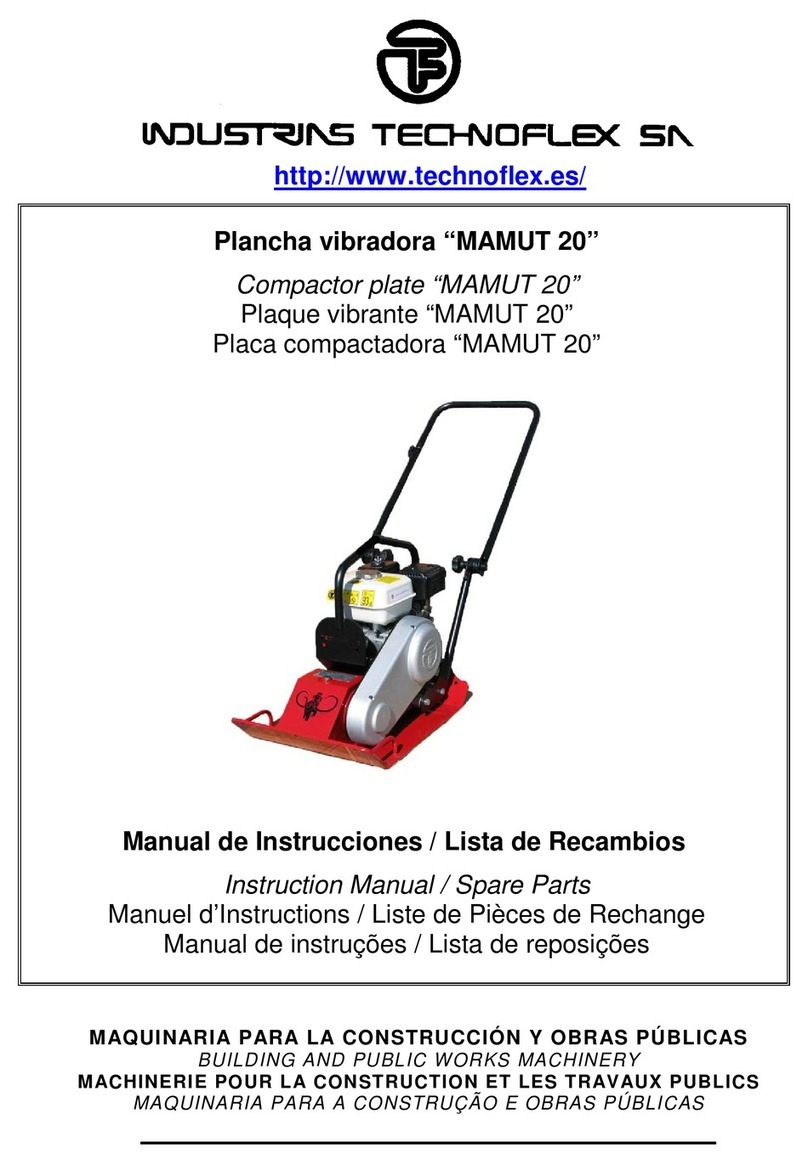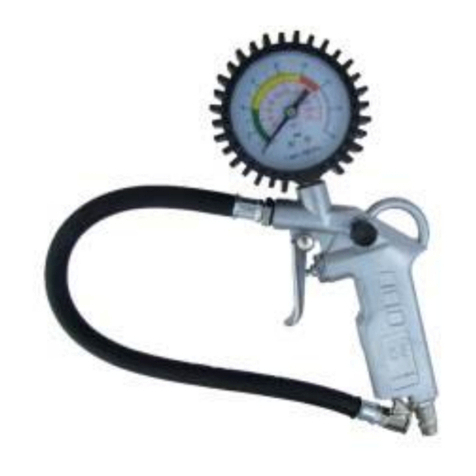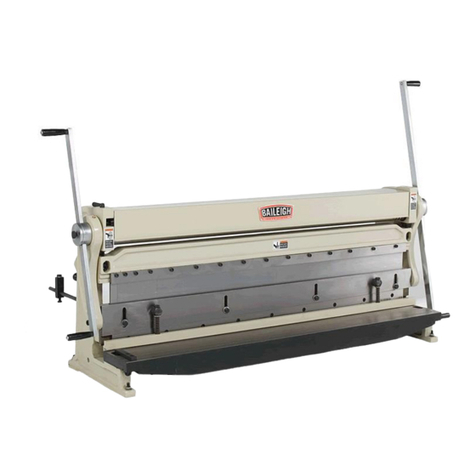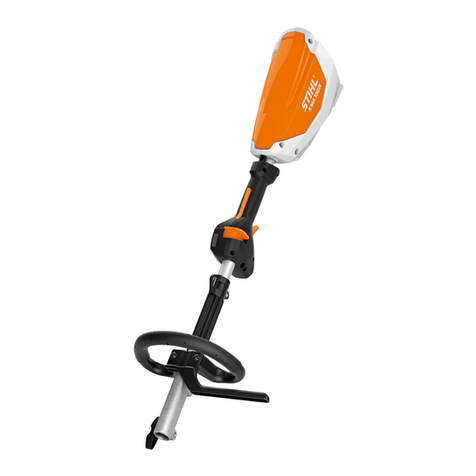Delta 22-590X User manual

22-590X
Instruction Manual
To reduce the risk of serious injury, thoroughly read and comply with all warnings and instructions in this manual and on product
KEEP THIS MANUAL NEAR YOUR PRODUCT FOR EASY REFERENCE AND TO INSTRUCT OTHERS
www.DeltaMachinery.com
13 inch Portable Planer

2
TABLE OF CONTENTS
FEATURES....................................................................2
IMPORTANT SAFETY INSTRUCTIONS .........................4
SAFETY GUIDELINES - DEFINITIONS .........................4
GENERAL SAFETY RULES.............................................5
PLANER SAFETY RULES ...............................................6
PROPOSITION 65 WARNING ......................................6
POWER CONNECTIONS ...............................................7
POWER SOURCE ............................................................7
GROUNDING INSTRUCTIONS .........................................7
ELECTRICAL CONNECTION..............................................7
POLARIZED PLUGS .........................................................7
EXTENSION CORDS ........................................................7
UNPACKING ................................................................8
UNPACKING AND CLEANING............................................8
PACKAGE CONTENTS .....................................................8
ASSEMBLY ...................................................................9
ATTACHING THE CUTTERHEAD LOCK HANDLE ..................9
ATTACHING THE CUTTERHEAD HEIGHT ADJUSTING
HANDLE .........................................................................9
PREPARING FOR DUST MANAGEMENT ..........................10
FASTENING THE PLANER TO A SUPPORTING SURFACE ...11
OPERATION ...............................................................11
STARTING AND STOPPING THE PLANER.........................11
USING THE CUTTERHEAD LOCK ....................................12
ADJUSTING THE HEAD ASSEMBLY..................................12
USING THE MATERIAL REMOVAL GAUGE........................12
RECOMMENDED DEPTH OF CUT ....................................13
USING THE DEPTH STOP...............................................13
USING THE ADJUSTABLE INDEXING RING ......................14
MINIMUM/MAXIMUM WIDTH/HEIGHT/DEPTH.................14
PROPER PLANING TECHNIQUES ....................................14
MAINTENANCE/ADJUSTMENTS.................................15
CHECKING, ADJUSTING, CLEANING AND REPLACING
KNIVES ........................................................................15
ADJUSTING THE IN-FEED AND OUT-FEED TABLES ..........17
CALIBRATING THE INDICATOR ARROW..........................18
WEAR TABLE AND IN-FEED/ OUT-FEED TABLE
MAINTENANCE .............................................................18
CIRCUIT BREAKER RESET BUTTON ................................18
BRUSH CHANGE............................................................18
REPLACING THE DRIVE BELT ........................................18
KEEP MACHINE CLEAN ..................................................18
LUBRICATION...............................................................18
TROUBLESHOOTING .................................................19
FAILURE TO START .......................................................19
ACCESSORIES ...........................................................19
PARTS, SERVICE OR WARRANTY ASSISTANCE.........20
The DELTA®Model 22-590X is a 13 inch (330mm) Portable
Planer with a cutting capacity of 1/8 inch (3.2mm). This Planer
can be used on boards up to 13 inch wide (330mm) and 6 inch
thick (152mm). This machine has a powerful 15 amp 120 volt
motor with a three-knife cutterhead.
NOTE: You can make a 1/8 inch (3.2mm) depth-of-cut in soft
woods up to 6 inch (152mm) wide and in hard woods up to 4
inch (102mm) wide. For more information see “Recommended
Depth of Cut section” on page 13.
FEATURES
NOTICE: The cover illustration shows the current production
model configuration. All other illustrations contained in the
manual are representative ONLY and may not depict the
actual labeling or accessories included. These are intended to
illustrate technique ONLY.
MOTOR SPECIFICATIONS
Your machine is wired for 120 volt, 60 Hz alternating current.
Before connecting the machine to the power source, make sure
the switch is in the “OFF” position.
Supply Voltage: 120 V AC~
Current: 15 A
Frequency: 60 Hz
No Load RPM: 10,000/min
SPECIFICATIONS

3
FIGURE 1
FEATURES
F9
F11
F12
F13
F14
F15
F16
F17
F5
F6
F7
F8
F1
F2
F3
F4
F9
F10
F10
F11
F12
F13
F14
F16
F17
F5
F6
F7
F8
F1
F2
F3
F4
Cutterhead Height Adjusting Handle
Micro Adjustment
Main Housing
Indicator Arrow
Base
Dust Deector
Wear Table
Out-feed Table
Cutterhead Lock Handle
Cutterhead Lock Release
Wrench Storage
(Under Table)
Dust Collection
Attachment
F15
In-feed Table
Depth Stop Knob / Lock
Material Removal Gauge
On/O Switch
Reset Button

4
IMPORTANT SAFETY INSTRUCTIONS
READ AND UNDERSTAND ALL WARNINGS AND OPERATING INSTRUCTIONS BEFORE
USING ANY TOOL OR EQUIPMENT. ALWAYS FOLLOW BASIC SAFETY PRECAUTIONS TO REDUCE THE
RISK OF PERSONAL INJURY. Improper operation, maintenance, or modification of tools or equipment could result
in serious injury and property damage. There are certain applications for which tools and equipment are designed. DO
NOT modify and/or use this product for ANY application other than that for which it was designed.
If you have any questions or concerns relative to the use of your tool or the contents of this manual, stop using the tool and contact
DELTA®Customer Service (toll free) 1-800-223-7278.
• Power Tool Institute, 1300 Sumner Avenue, Cleveland, OH 44115-2851 or online at www.powertoolinstitute.com.
• National Safety Council, 1121 Spring Lake Drive, Itasca, IL 60143-3201.
• American National Standards Institute, 25 West 43rd Street, 4 floor, New York, NY 10036 www.ansi.org - ANSI 01.1 Safety
Requirements for Woodworking Machines.
• U.S. Department of Labor regulations www.osha.gov.
SAFETY GUIDELINES - DEFINITIONS
It is important for you to read and understand this manual. The information it contains relates to protecting YOUR SAFETY and
PREVENTING PROBLEMS. The symbols below are used to help you recognize this information.
Indicates an imminently hazardous situation which, if not avoided, will result in death or serious injury.
Indicates a potentially hazardous situation which, if not avoided, could result in death or serious injury.
Indicates a potentially hazardous situation which, if not avoided, may result in minor or moderate injury.
Indicates a practice not related to personal injury which, if not avoided, may result in property damage.
Some of the following symbols may be used on the tool. Please study them and learn their meaning. Proper interpretation on
these symbols will allow you to operate the tool better and safer.
SYMBOL NAME DESIGNATION/EXPLANATION
Safety Alert Indicates a potential personal injury hazard.
Read Operator's Manual To reduce the risk of injury, user must read and understand operator's manual before using this
product.
Eye Protection Always wear eye protection with side shields marked to comply with ANSI Z87.1.
No Hands Symbol Failure to keep your hands away from the blade will result in serious personal injury.
Wet Conditions Alert Do not expose to rain or use in damp locations.
Pinch Warning Always watch for movement paying extra attention to potential areas where pinching could occur.
V Volts Voltage
A Amperes Current
Hz Hertz Frequency (cycles per second)
min Minutes Time
~/AC Alternating Current Type of current
ⁿ
ᴏ
No Load Speed Rotational speed, at no load
.../min Per Minute Revolutions, strokes, surface speed, orbits, etc., per minute
Lbs Pounds Unit of weight
Kg Kilograms Unit of weight
RPM Revolutions Per Minute Speed of rotation of machine
PH:1 Phase 1 This is a 1 phase motor

5
1. For your own safety, read the instruction manual before operating the machine. Learning the machine’s
application, limitations, and specific hazards will greatly minimize the possibility of accidents and injury.
2. Wear eye and hearing protection and ALWAYS use safety glasses. Everyday eyeglasses are not safety glasses.
Use certified safety equipment. Eye protection equipment should comply with ANSI Z87.1 standards. Hearing equipment
should comply with ANSI S3.19 standards.
3. Wear proper apparel. Do not wear loose clothing, gloves, neckties, rings, bracelets, or other jewelry which may get
caught in moving parts. Nonslip protective footwear is recommended. Wear protective hair covering to contain long hair.
4. Do not use the machine in a dangerous environment. The use of power tools in damp or wet locations or in rain
can cause shock or electrocution. KEEP your work area well-lit to prevent tripping or placing arms, hands, and fingers in
danger.
5. Do not operate electric tools near flammable liquids or in gaseous or explosive atmospheres. Motors and
switches in these tools may spark and ignite fumes.
6. Maintain all tools and machines in peak condition. KEEP tools sharp and clean for best and safest performance.
Follow instructions for lubricating and changing accessories. Poorly maintained tools and machines can further damage
the tool or machine and/or cause injury.
7. Check for damaged parts. Before using the machine, check for any damaged parts. Check for alignment of moving
parts, binding of moving parts, breakage of parts, and any other conditions that may affect its operation. A guard or any
other part that is damaged should be properly repaired or replaced with DELTA®or factory authorized replacement parts.
Damaged parts can cause further damage to the machine and/or injury.
8. KEEP the work area clean. Cluttered areas and benches invite accidents.
9. KEEP children and visitors away. Your shop is a potentially dangerous environment. Children and visitors can be
injured.
10. Reduce the risk of unintentional starting. Make sure that the switch is in the “OFF” position before plugging in the
power cord. In the event of a power failure, move the switch to the “OFF” position. An accidental start-up can cause
injury. Do not touch the plug’s metal prongs when unplugging or plugging in the cord.
11. Use the guards. Check to see that all safety devices are in place, secured, and working correctly to prevent injury.
12. Remove adjusting keys and wrenches before starting the machine. Tools, scrap pieces, and other debris can be
thrown at high speed, causing injury.
13. Use the right machine. Do not force a machine or an attachment to do a job for which it was not designed. Damage to
the machine and/or injury may result.
14. Use recommended accessories. The use of accessories and attachments not recommended by DELTA®may cause
damage to the machine or injury to the user.
15. Use the proper extension cord. Make sure your extension cord is in good condition. When using an extension cord,
be sure to use one heavy enough to carry the current your product will draw. An undersized cord will cause a drop in line
voltage, resulting in loss of power and overheating. See the Extension Cord Chart for the correct size depending on the
cord length and nameplate ampere rating. If in doubt, use the next heavier gauge. The smaller the gauge number, the
heavier the cord.
16. Secure the workpiece. Use clamps or a vise to hold the workpiece when practical. Loss of control of a workpiece can
cause injury.
17. Feed the workpiece against the direction of the rotation of the blade, cutter, or abrasive surface. Feeding it
from the other direction will cause the workpiece to be thrown out at high speed.
18. Do not force the workpiece on the machine. Damage to the machine and/or injury may result.
19. Do not overreach. Loss of balance can make you fall into a working machine, causing injury.
20. NEVER stand on the machine. Injury could occur if the tool tips, or if you accidentally contact the cutting tool.
21. NEVER leave the machine running unattended. Turn the power off. Don’t leave the machine until it comes to a
complete stop. A child or visitor could be injured.
22. Turn the machine “OFF”, and disconnect the machine from the power source before installing or removing
accessories, changing cutters, adjusting or changing set-ups. When making repairs, be sure to lock the start
switch in the “OFF” position. An accidental start-up can cause injury.
23. Make your workshop childproof with padlocks, master switches, or by removing starter keys. The accidental
start-up of a machine by a child or visitor could cause injury.
24. Stay alert, watch what you are doing, and use common sense. Do not use the machine when you are tired or
under the influence of drugs, alcohol, or medication. A moment of inattention while operating power tools may result in
injury.
25. Use of this tool can generate and disperse dust or other airborne particles, including wood
dust, crystalline silica dust and asbestos dust. Direct particles away from face and body. ALWAYS operate tool in
well ventilated area and provide for proper dust removal. Use dust collection system wherever possible. Exposure to the
dust may cause serious and permanent respiratory or other injury, including silicosis (a serious lung disease), cancer, and
death. Avoid breathing the dust, and avoid prolonged contact with dust. Allowing dust to get into your mouth or eyes,
or lay on your skin may promote absorption of harmful material. ALWAYS use properly fitting NIOSH/OSHA approved
respiratory protection appropriate for the dust exposure, and wash exposed areas with soap and water.
GENERAL SAFETY RULES
Failure to follow these rules may result in serious personal injury.

6
FAILURE TO FOLLOW THESE RULES MAY RESULT IN SERIOUS PERSONAL INJURY.
PLANER SAFETY RULES
1. Do not operate this machine until it is completely assembled and installed according to the instructions. A machine
incorrectly assembled can cause serious injury.
2. Obtain advice from your supervisor, instructor, or another qualified person if you are not thoroughly familiar with the operation
of this machine. Knowledge is safety.
3. Follow all wiring codes and recommended electrical connections to prevent shock or electrocution.
4. Keep knives sharp and free from rust and pitch. Dull or rusted knives work harder and can cause kickback.
5. Never turn the machine “ON” before clearing the table of all objects (tools, scraps of wood, etc.). Flying debris can cause
serious injury.
6. Never turn the machine “ON” with the work-piece contacting the cutterhead. Kickback can occur.
7. Secure the machine to a supporting surface to prevent the machine from sliding, walking or tipping over.
8. Properly secure the knives in the cutter-head before turning the power “ON”. Loose blades may be thrown out at high
speeds causing serious injury.
9. Do not place the power cord under the cutterhead when moving or storing.
10. Avoid awkward operations and hand positions. A sudden slip could cause a hand to move into the knives.
11. Keep arms, hands, and fingers away from the cutterhead, the chip exhaust opening, and the feed rollers to prevent severe
cuts.
12. Never reach into the cutterhead area while the machine is running. Your hands can be drawn into the knives.
13. Do not stand in line of the workpiece. Kickback can cause injury.
14. Allow the cutterhead to reach full speed before feeding a workpiece.
15. When planning stock, place the concave (cup down) side of the stock on the table and cut with the grain to prevent kickback.
16. Do not feed workpiece that is warped, contains knots, or is embedded with foreign objects (nails, staples, etc.). Kickback
can occur.
17. Do not feed a short, thin, or narrow workpiece into the machine. Your hands can be drawn into the knives and/or the
workpiece can be thrown at high speeds. See the “OPERATION” section of this instruction manual for details.
18. Do not feed workpiece into the out-feed end of the machine. The workpiece will be thrown out of the opposite side at high
speeds.
19. Remove shavings only with the power “OFF” to prevent serious injury.
20. Use for wood only. Do not plane man-made materials.
21. Properly support long or wide workpieces. Loss of control of the workpiece can cause serious injury.
22. Never perform layout, assembly or set-up work on the table/work area when the machine is running. Serious injury will
result.
23. Turn the machine “OFF”, disconnect it from the power source, and clean the table/work area before leaving the
machine. Lock the switch in the “OFF” position to prevent unauthorized use.
24. Additional information regarding the safe and proper operation of power tools (i.e. a safety video) is available from the
Power Tool Institute, 1300 Sumner Avenue, Cleveland, OH 44115-2851 (www.powertoolinstitute.com). Information is also
available from the National Safety Council, 1121 Spring Lake Drive, Itasca, IL 60143-3201. Please refer to the American
National Standards Institute ANSI 01.1 Safety Requirements for Woodworking Machines and the U.S. Department of Labor
Regulations.
PROPOSITION 65 WARNING:
Dust created by power sanding, sawing, grinding, drilling, and other construction activities may contain
chemicals known to the state of California to cause cancer, birth defects or other reproductive harm. Some examples are:
• Lead from lead-based paints
• Crystalline silica from bricks and cement and other masonry products
• Asbestos dust
• Arsenic and chromium from chemically-treated lumber
Your risk from these exposures varies depending on how often you do this type of work. To reduce your exposure to these
chemicals: work in a well-ventilated area and work with approved safety equipment, such as dust masks that are specifically
designed to filter out microscopic particles.
Avoid prolonged contact with dust from power sanding, sawing, grinding, drilling, and other construction activities.
Wear protective clothing and wash exposed areas with soap and water.
SAVE THESE INSTRUCTIONS
Refer to them often and use them to instruct others. • If tool is loaned to someone, also loan them these instructions.

7
POWER CONNECTIONS
POWER SOURCE
This planer is equipped with a 15-amp motor for use with a 120-volt, 60-HZ alternating current. See instructions below
regarding proper connections for your saw as wired.
For voltage, the wiring in a shop is as important as the motor’s rating. A line intended ONLY for lights may not be able to
properly carry the current needed for a power tool motor; wire that is heavy enough for a short distance may be too light for
a greater distance; and a line that can support one power tool may not be able to support two or three. A separate electrical
circuit should be used for your machines. This circuit should not be less than #12 wire and recommended to be protected with
a 20-amp circuit breaker or a 20-amp time lag fuse. If an extension cord is used, use ONLY 3-wire extension cords which
have 3-prong grounding-type plugs and matching receptacle which will accept the machine’s plug. Before connecting the
machine to the power line, make sure the switch(s) is in the “OFF” position and be sure that the electric current is of the same
characteristics as indicated on the machine. A substantial voltage drop will cause a loss of power and overheat the motor. It
may also damage the machine.
Your machine is wired for 120 volts, 60 HZ alternating current. Before connecting the machine to the power source, make sure
the switch is in the “OFF” position.
DO NOT EXPOSE THE MACHINE TO RAIN OR OPERATE THE MACHINE IN DAMP LOCATIONS.
This tool has a precision-built electric motor. It should be connected to a POWER SUPPLY THAT IS 120 VOLTS, 60 HZ, AC ONLY
(NORMAL HOUSEHOLD CURRENT in the U.S. and Canada). DO NOT operate this tool on direct current (DC). A substantial
voltage drop will cause a loss of power and the motor will overheat. If the tool does not operate when plugged into an outlet,
double-check the power supply.
ELECTRICAL CONNECTION
POLARIZED PLUGS
To reduce the risk of electric shock, this equipment has a polarized plug (one blade is wider than the other). This plug will fit
in a polarized outlet ONLY one way. If the plug does not fully fit in the outlet reverse the plug. If it still does not fit, contact a
qualified electrician to install the proper outlet. DO NOT change the plug in any way.
1. All grounded, cord-connected machines:
In the event of a malfunction or breakdown, grounding provides a path of least resistance for electric current to reduce
the risk of electric shock. This machine is equipped with an electric cord having an equipment-grounding conductor and
a grounding plug. The plug must be plugged into a matching outlet that is properly installed and grounded in accordance
with all local codes and ordinances.
DO NOT modify the plug provided - if it will not fit the outlet, have the proper outlet installed by a qualified electrician.
Improper connection of the equipment-grounding conductor can result in risk of electric shock. The conductor with
insulation having an outer surface that is green with or without yellow stripes is the equipment-grounding conductor. If
repair or replacement of the electric cord or plug is necessary, DO NOT connect the equipment-grounding conductor to a
live terminal.
Check with a qualified electrician or service personnel if the grounding instructions are not completely understood, or if in
doubt as to whether the machine is properly grounded.
Use ONLY 3-wire extension cords that have 3-prong grounding type plugs and matching 3-conductor receptacles that
accept the machine’s plug.
Repair or replace damaged or worn cord immediately.
In all cases, make certain that the receptacle in question is properly grounded. If you are not sure,
have a qualified electrician check the receptacle.
GROUNDING INSTRUCTIONS
This machine must be grounded while in use to protect the operator from electric shock.

8
UNPACKING
UNPACKING AND CLEANING
PACKAGE CONTENTS
Carefully unpack the machine and all loose items from the shipping container. Figure 2 illustrates the planer and all loose items
supplied with your machine. Refer to the section of this manual titled “Replacing Knives”to remove the dust deflector. Remove
any rust-preventative oil from unpainted surfaces using a soft cloth moistened with mineral spirits, paint thinner or denatured
alcohol.
DO NOT use highly volatile solvents such as gasoline, naphtha, acetone or lacquer thinner for cleaning your machine.
After cleaning, cover the unpainted surfaces with a good quality household floor paste wax.
Take care when you clean the cutterhead. The knives in the cutterhead are very sharp. After cleaning the
cutterhead, replace the dust deflector.
This machine weighs about 75 pounds. Use a helper to lift or move it.
22-590X Portable Planer
Dust Collection Attachment
Cutterhead Height Adjusting Handle
Cutterhead Lock Handle
T-Handle T30 Torx Wrench
M6 x 20mm Torx Head Screw (6)
6.5mm x 16mm x2mm Flat Washer (4)
M6 Split Lock Washer (2)
FIGURE 2
PC1
PC1
PC2
PC2
PC3
PC3
PC4
PC4
PC5
PC5
PC6
PC7
PC8
PC6
PC6
PC7
PC8
POWER CONNECTIONS
006827
Hardware Bag 1:
Hardware Bag 2:
006846
006767
006767
When using a power tool at a considerable distance from a power source, be sure to use a 3-prong extension cord that has the
capacity to handle the current the tool will draw. An undersized cord will cause a drop in line voltage, resulting in overheating
and loss of power. Use the chart to determine the minimum wire size required in an extension cord. ONLY round jacketed cords
listed by Underwriter’s Laboratories (UL) should be used.
NOTE: Before using any extension cord, inspect it for loose or
exposed wires and cut or worn insulation. ** Ampere rating (on total data label)
12A-16A
Cord Length Wire Size
25' 14 AWG
50' 12 AWG
** Used on 12 gauge - 20 amp circuit
NOTE: AWG = American Wire Gauge
EXTENSION CORDS
KEEP the extension cord clear of the work
area. Position the cord so that it will not get caught on lumber,
tools or other obstructions while you are working with a power
tool. Failure to do so can result in serious personal injury.
Check extension cords before each use. If damaged replace
immediately. NEVER use tool with a damaged cord, since
touching the damaged area could cause electrical shock
resulting in serious injury.

9
ASSEMBLY
To reduce the risk of injury, turn unit off and disconnect the machine from power source before installing
and removing accessories, before adjusting and when making repairs. An accidental start-up can cause injury.
ASSEMBLY TOOLS REQUIRED
T-Handle T30 Torx Wrench PC5 (Supplied)
See Figure 4.
1. Attach the cutterhead height adjusting handle PC3 to the
shaft B, aligning the at edge of the shaft with the
at edge in the handle.
2. Fasten the cutterhead height adjusting handle to the
shaft using the M6 x 20mm Torx Head Screw PC6 and
M6 Split Lock Washer PC8 with the supplied T-Handle
T30 Torx Wrench PC5 .
NOTE: The cutterhead height adjusting handle is supplied with
markings on the dial to make your cuts accurate.
See Figure 3.
1. Use the supplied T-Handle T30 Torx Wrench PC5 to
attach the cutterhead lock handle PC4 to the shaft A
with the M6 x 20mm Torx Head Screw PC6 and M6
Split Lock Washer PC8 .
ATTACHING THE CUTTERHEAD
LOCK HANDLE
FIGURE 3
ATTACHING THE CUTTERHEAD
HEIGHT ADJUSTING HANDLE
FIGURE 4
PC3
PC4
PC6
PC6
PC8
PC8
A
B

10
ASSEMBLY
INSTALLING THE DUST COLLECTION
ATTACHMENT
1. Using the cutterhead height adjusting handle PC3 , raise
the main housing up high enough to allow clearance
for the T-Handle T30 Torx Wrench PC5 .
2. Using the wrench provided, remove the two M6 x
20mm Torx screws PC6 and flat washers PC7 that
secure the dust deector F11 . Save these for step 4.
See Figures 5 & 6.
3. Remove the dust deector F11 . See Figure 7.
4. Align the four slots in the dust collection attachment
F17 with holes in the frame, see Figure 8. Secure using
four M6 x 20mm Torx screws PC6 and at washers PC7
(two from step 2).
5. Reverse the procedure to reinstall the dust deector.
Install the dust deector with the label up and curved
lip pointing down.
6. Store the extra mounting screws with the dust
collection attachment when it is not in use.
ALWAYS disconnect the machine from
the power source before removing or installing any
attachment or accessory.
You have two options for dust management. The rst is the
dust deector and the second is the dust collection attachment
to attach your machine to a dust collector.
NOTE: The dust deector comes factory installed and can be
used if the user elects not to use a dust collector system.
PREPARING FOR DUST
MANAGEMENT
When using the dust collection attachment,
DO NOT operate the unit without a hose connected and a
dust collector in operation. The dust collection attachment is
designed to accept a 4 inch hose. ALWAYS replace the dust
deflector when the dust collection attachment is not in use.
FIGURE 5
FIGURE 6
FIGURE 7
FIGURE 8
PC6
F11
PC6
PC5
F17

11
Before operation, secure the planer to the
supporting surface.
Operate the planer on a at, level surface.
OPERATION
STARTING AND STOPPING THE
PLANER
See Figures 10 & 11.
1. To turn the planer “ON”, lift the paddle F9 . To turn
the tool “OFF”, push the paddle down.
IMPORTANT: When the machine is not in use, the switch
should be locked in the “OFF” position, see Figure 11, to
prevent unauthorized use. Place a padlock Awith a 1/4 inch
(6.3mm) diameter shackle through the hole on the left side of
the switch cover and through the hole in the switch paddle.
Lock the padlock. See Figure 12.
Ensure the lock is inserted in the holes
correctly which will prevent the switch from being
turned on.
FIGURE 11
FIGURE 12
FIGURE 10
ASSEMBLY
FASTENING THE PLANER TO A
SUPPORTING SURFACE
1. Four mounting holes Aare provided for mounting the
planer to a stand or work surface. These holes are
located under the in-feed and out-feed tables (two of
which are shown in Figure 9).
FIGURE 9
A
F9
ONON
A
OFFOFF

12
OPERATION
USING THE CUTTERHEAD LOCK
The cutterhead lock PC4 , see Figure 13, prevents the
cutterhead depth from being able to change. This helps to
eliminate snipe in the board that is being planed. Snipe can also
be eliminated by butting boards end to end and feeding them
through the planer. Long boards should ALWAYS be
supported, when feeding them through the planer to help
eliminate snipe.
NOTE: To lock the cutterhead, turn handle clockwise. To
unlock, turn handle counterclockwise.
FIGURE 13
The main housing contains the cutterhead, feed rollers,
dust deflector and motor. Raising and lowering the main
housing controls the depth of cut.
1. To adjust the main housing, unlock the cutterhead lock
handle PC4 , see Figure 13. Turn the cutterhead height
adjusting handle PC3 clockwise to raise or
counterclockwise to lower the cutterhead. One
revolution of the handle in Figure 14 will move the
cutterhead up or down 1/16 inch (1.6mm). Once the
cutterhead is at the desired height, lock the cutterhead
assembly in place by engaging the cutterhead lock
handle.
ADJUSTING THE HEAD ASSEMBLY
FIGURE 14
Lock
Unlock
PC3
PC4
USING THE MATERIAL REMOVAL
GAUGE
See Figure 15.
Your planer is equipped with a material removal gauge A. It
is used to indicate the amount of wood that will be removed in
one pass with the carriage set at its current height. The material
removal gauge reads across the entire width of the planer
head.
1. Slide approximately 3 inches of the workpiece B
under the carriage.
2. Be sure that the workpiece is lying at against the table
of the planer. If the workpiece is inserted at an angle,
the reading may be inaccurate.
3. Lower the carriage on the workpiece until the material
removal bar engages the wood. You will see the red
arrow Amoving up the scale to indicate the amount
to be removed with the carriage at that height.
4. Adjust the carriage height until the desired depth of cut
appears on the gauge.
NOTE: Record this depth as you may have to back the
cutterhead o the board to allow you to remove it. Once this is
done, pull the material out from under the carriage and reset
the cutterhead to the desired depth.
5. Turn the unit on and feed your material into the cutter
head.
FIGURE 15
A
B

13
NOTE: DO NOT exceed the recommended depth of cut for
various widths of material, shown in the “RECOMMENDED
DEPTH OF CUT” section below.
DO NOT turn the unit “ON” with the work-
piece in position.
1/16 inch
(1.6mm)
3/64 inch
(1.2mm)
3/32 inch
(2.4mm)
1/8 inch
(3.2mm)
2 inch
(51mm)
4 inch
(102mm)
SOFT WOOD
HARD WOOD
RECOMMENDED DEPTH OF CUT
6 inch
(152mm)
7 inch
(178mm)
8 inch
(203mm)
9 inch
(229mm)
10 inch
(254mm)
WIDTH OF STOCK
FIGURE 16
RECOMMENDED DEPTH OF CUT
See Figure 16.
NOTE: One revolution of the cutterhead height adjusting
handle will move the cutterhead up or down 1/16 inch
(1.6mm).
You can make a 1/8 inch (3.2mm) depth-of-cut in soft woods
up to 6 inch (152mm) wide and in hard woods up to 4 inch
(102mm) wide.
For 6 inch (152mm) through 13 inch (330mm) wide soft
wood, use a maximum depth-of-cut of 1/16 inch (1.6mm). For
4 inch (152mm) through 13 inch (330mm) wide hard wood,
use a maximum depth-of-cut of 3/64 inch (1.2mm).
IMPORTANT: A shallow depth-of-cut will produce a better
finish.
To set the maximum depth (or minimum thickness) to which
the cutterhead can travel with the depth stop:
1. Check to see that the cutterhead is set above 1 1/4
inch before trying to set the depth stop.
2. Make sure dial F7 is unlocked by rotating the locking
knob Bcounterclockwise.
3. Turn the dial F7 to the desired thickness setting so
that it aligns with the indicator line A, as shown in
Figure 17.
4. Lock the gauge in place by turning the locking knob
Bclockwise, as shown in Figure 17.
5. Plane the workpiece at desired increments until the
correct nal thickness is achieved.
NOTE: DO NOT use force to lower the carriage below the
level that the depth stop indicates. This will result in permanent
damage to the height adjustment system on your planer.
USING THE DEPTH STOP
Your planer is equipped with a depth stop dial for repetitive
planing, as shown in Figure 17. Any thickness between 1/8 inch
and 1 1/4 inch can be selected using the scale on the depth
stop. Detents are provided at 1/8 inch, 1/4 inch, 1/2 inch, 3/4
inch, 1 inch, and 1 1/4 inch.
FIGURE 17
OPERATION
A
B
F7

14
MINIMUM/MAXIMUM WIDTH/HEIGHT/DEPTH
NOTE: ALWAYS plane in the direction of the grain. Support the workpiece adequately at all times. Planing material less than
3/4 inch wide is not recommended. If you must plane narrow material, group several pieces together and plane them as one
wide workpiece whenever possible. The maximum depth of cut your planer can take in one pass is 1/8 inch (soft wood). NEVER
attempt to modify your planer to take a deeper cut. Follow the recommended depth/width of cut guidelines shown in Figure 16
for best results.
1. Once the initial cut has been made and ne tuning is
required, measure the thickness of the planed board.
2. Set the ring AFigure 18 to align the zero with the
arrow B.
3. Unlock the Cutterhead Lock Handle and rotate the handle
to the desired depth of cut, as indicated on the ring. Each
indicator on the ring is equivalent to 1/128 inch (.2mm)
for making minute cuts.
4. Plane the workpiece and then repeat this process until
you reach the nal desired thickness.
USING THE ADJUSTABLE
INDEXING RING
Follow these few steps to achieve the best results.
1. True One Face – Feed one face of the board over a jointer, making thin cuts with each pass, until the entire surface is
flat.
2. Plane to Thickness – Place the side you just surfaced in STEP 1 face down and feed the board through the planer, plane
until this side is flat. Then plane both sides of the board until you are satisfied with the thickness, making thin cuts,
alternating sides with each pass. If, during the planing operation, you notice the board twisting, warping or bowing,
repeat STEP 1 and true one face.
3. When planing long stock, provide additional support to the in-feed and out-feed end of the workpiece.
4. ALWAYS engage the cutterhead lock before planing. Plane with the grain ONLY, and KEEP table clean. Occasionally, wax
the table surface to reduce friction.
5. Cross-cut the workpiece to its final length.
NOTE: When ever possible, feed the wood through the planer at different places on the table to help eliminate uneven wear
of the knives.
The cutterhead height adjusting handle has an adjustment ring
Figure 18. The Adjustable Index Ring is best utilized after the
initial cut has been made.
To use the adjustment ring to make fine adjustments:
PROPER PLANING TECHNIQUES
1. Lower the carriage to the desired height for your rst pass and lock the cutterhead using the Cutterhead Lock Handle.
2. Turn the unit on and feed the material into the feed rollers.
3. Examine the cut and adjust the carriage to the appropriate height for your next pass.
4. When possible feed workpieces through alternating areas of the planer for even blade wear – not just through the center
of the machine. One way to do this is to start with the workpiece on the left for the rst pass, in the middle on the next
and on the right side for third pass – and then repeat.
NOTE: Flip the board over between each pass.
DO NOT turn the unit on with the workpiece inserted under cutterhead. Wait until the roller and cutterhead are
up to full speed before feeding your material into the machine.
For best results, plane both sides of the workpiece to reach desired thickness. For example, if you need to remove 1/8 inch from
your workpiece, remove 1/16 inch from each side. This not ONLY allows the workpiece to dry with an even moisture content, it
also produces ner cuts.
Plane ONLY wood that is free from foreign objects, with no loose knots and as few tight knots as possible. DO
NOT plane wood that is severely warped, twisted, knotted or bowed.
DO NOT place your body between the rear of the planer and a stationary object while material is feeding. Serious
injury could result.
FIGURE 18
OPERATION
A
B

15
SNIPE
Snipe is a depression made when an unsupported end of your material drops toward the oor, causing the opposite end to lift up
into the cutter head.
TO AVOID SNIPE
• Feed the workpiece into the planer so it is level and remains at against the table at all times.
• KEEP the workpiece level throughout planing operation by receiving or “catching” it from the rear of the planer. If you are
planing material that is especially long, the use of additional material support is recommended.
TWISTED, CUPPED AND BOWED WOOD
If both sides of your material are very rough or if the material is cupped, bowed or twisted, your planer may not produce the desired
result. Ideally, you should have at least one at surface/face on your material before you plane. Your thickness planer will work best
with material that has been run through a jointer to produce one at surface. If you DO NOT have at least one at surface or a
jointer, see the following recommendations.
TO PLANE TWISTED WOOD
Twisted wood may jam your planer. If a jam occurs, turn the power “OFF”, disconnect the power
supply and raise the cutterhead to release the workpiece from the cutter.
If your material is only SLIGHTLY twisted, plane both sides alternating from one to the other until the desired thickness is reached.
TO PLANE CUPPED WOOD
To obtain the best possible results with cupped wood, rip the material down the middle and plane it as two separate pieces. Ripping
the material reduces the severity of the cup and allows the machine to deliver better results. Understand that you will have to remove
more material on cupped wood to achieve the desired thickness than you would on a normal board. If ripping the material is not an
option, plane one side of the material until at, then plane the opposite side until it is also at. Start with the cupped portion of the
board facing down.
NOTE: DO NOT ip the board back and forth between each pass as recommended by the general planing directions.
TO PLANE BOWED WOOD
The feed rollers and cutter head in your planer will push the bow out of the material as it feeds. However, when the material exits the
planer, the pressure of the rollers and cutterhead will release allowing the wood to spring back into a bowed formation. To properly
remove the bow, use a jointer.
MAINTENANCE/ADJUSTMENTS
To reduce the risk of injury, turn unit off
and disconnect the machine from power source before
installing and removing accessories, before adjusting or
when making repairs. An accidental start-up can cause
injury.
Wear gloves when you remove the
knives for sharpening or replacement. The knives in
this planer are very sharp.
The knives are sharp. Be careful when
removing, handling, or installing knives.
The knives supplied with your planer are double edged and
reversible so that you can turn the knives end-for-end when
one edge becomes dull or chipped. To change the knives see
Figures 19 - 22.
1. Raise the cutter head assembly to 4 inch (102mm) on
the “Scale and Pointer”.
2. Remove the screws A. Pull the dust deector or dust
collection attachment – whichever is installed – B
straight out.
3. Insert the supplied wrench PC5 into the hex hole.
Rotate the cutterhead until the cutterhead lock
engages.
4. Remove the seven screws Eand use magnetic end
of the wrench to remove the hold-down bar F.
FIGURE 19
FIGURE 20
OPERATION
PC5
A
B
CHECKING, ADJUSTING,
CLEANING AND REPLACING
KNIVES

16
MAINTENANCE/ADJUSTMENTS
FIGURE 21
FIGURE 22
FIGURE 23
5. Place the magnetized end of the wrench PC5 at the
center of the knife. Lift the wrench until the knife H
separates from the pins. Remove the knife.
6. Repeat STEPS 3 through 5to remove the other two
knives. Press down the cutterhead lock release F15 and
use the supplied wrench PC5 to rotate the cutterhead
until the lock engages and the next knife is in position
to be removed.
7. IMPORTANT: After removing all knives from
cutterhead, carefully set them aside. Using a cloth rag
and isopropyl alcohol, carefully clean the cutterhead,
knives and hold-down bars to remove all gum, tar and
pitch residue. Take special care to clean the cutterhead
under the knife area and the cutterhead radius in front
of the knife area. Doing this will increase the life of
your planer.
Remember to wear gloves while handling
knives.
8. Take this time also to clean the rollers I, see Figure
23.
9. Your unit is equipped with double-edged knives. If the
second edge of the knife has not been used, rotate
the knife 180 degrees and replace on the cutterhead.
Replace the knives if both sides have been used.
10. Attach the hold-down bar FFigure 21 that you
removed in STEP 4. Tighten all fasteners securely E.
11. Depress the cutterhead lock release F15 and rotate the
cutterhead to the next empty position until the
cutterhead lock engages.
12. Repeat steps 9 through 11 to replace the other knives.
13. Reattach the dust deflector or dust collection
attachment.
PC5
F15
E
F
H
I

17
ADJUSTING THE IN-FEED AND
OUT-FEED TABLES
Your unit has been factory set with careful table alignment to help
eliminate snipe. If your unit loses its adjustment and causes snipe,
you can adjust the in-feed and out-feed tables to minimize this
condition.
1. Raise the cutterhead.
2. Place a dime AFigure 24 at each end of the Wear
Table (in-feed and out-feed).
3. Place a straight edge Bacross the two dimes. Extend
the straight edge past the edges of the in-feed and
out-feed tables.
4. If your tables are properly adjusted, the straight edge
will touch both of the dimes and both the edges of the
tables.
5. If your table needs adjustment, loosen the lock
nuts DFigure 25 on the table height-adjustment
screws C. Adjust the screws up or down to achieve
the desired table height.
6. Make sure that both height-adjustment screws contact
the bottom of the table after adjustment.
7. Re-tighten lock nuts C.
FIGURE 24
FIGURE 25
MAINTENANCE/ADJUSTMENTS
AB
D
C
The depth adjustment scale F4 ,Figure 26, on your planer is
set at the factory. However, with extended use, the depth
adjustment scale could show an incorrect measurement. To
check the depth adjustment scale:
1. Plane a piece of scrap wood, noting the measurement
on the depth adjustment scale.
2. Measure the nished thickness of the workpiece. When
measuring the thickness, measure away from the ends.
Beware of snipe. Measuring the snipe could result in
inaccurate measurements.
3. If the thickness of the workpiece does not match the
reading on the depth adjustment scale, loosen the two
screws Bon the red indicator. Adjust the pointer up
or down until its reading matches the finished
thickness of the workpiece. Securely re-tighten the
screws.
CALIBRATING THE INDICATOR
ARROW
FIGURE 26
F4
B

18
KEEP the tables clean and free from oil, grease, and pitch. Treat
the tables with paste wax to help maintain its smooth nish.
WEAR TABLE AND IN-FEED/
OUT-FEED TABLE MAINTENANCE
Your planer is equipped with an 18 amp circuit breaker. If your
planer becomes overloaded and stops operating, turn o the
planer, let the unit sit for 2 minutes and press the reset button
F10 as shown in Figure 27 before you resume working.
CIRCUIT BREAKER RESET
BUTTON
To prevent the planer from starting
unexpectedly if power is interrupted by a circuit breaker
trip, make sure the switch is in the “OFF” position before
restoring power.
NOTE: Circuit breaker overload is often the result of dull knives.
Change your knives on a regular basis to avoid tripping your
breaker. Check your knives before re-setting the circuit breaker
and continuing to plane.
FIGURE 27
FIGURE 28
REPLACING THE DRIVE BELT
Drive belts are wear items. To purchase replacement belts, call
DELTA®Technical Service at (toll free) 1-800-223-7278.
KEEP MACHINE CLEAN
Periodically blow out all air passages with dry compressed air. All
plastic parts should be cleaned with a soft damp cloth. NEVER
use solvents to clean plastic parts. They could possibly dissolve
or otherwise damage the material.
Wear certified safety equipment for eye,
hearing and respiratory protection while using
compressed air.
BRUSH CHANGE
Your planer is equipped with replaceable motor brushes. If your
brushes need to be replaced, remove brush caps Cfrom
motor housing Figure 28, and replace brushes.
For proper motor function use ONLY identical
replacement brushes. For identical replacement brushes call
DELTA®Customer Service at (toll free) 1-800-223-7278 or
e-mail us at www.deltamachinery.com.
MAINTENANCE/ADJUSTMENTS
F10
C
LUBRICATION
Apply household floor paste wax to the machine table, extension
table and other work surface weekly. Or use a commercially
available protective product designed for this purpose. Follow
the manufacturer’s instructions for use and safety.

19
ACCESSORIES
A complete line of accessories is available from your DELTA®Supplier, DELTA®Factory Service Centers, and DELTA®Authorized
Service Centers. Please call DELTA®Customer Service at (toll free) 1-800-223-7278 or e-mail us at www.deltamachinery.com.
Since accessories other than those oered by DELTA®have not been tested with this product, use
of such accessories could be hazardous. For safest operation, ONLY DELTA®recommended accessories should be
used with this product.
TROUBLESHOOTING
For assistance with your machine, visit our website at www.deltamachinery.com for a list of service centers or call DELTA®
Technical Service at (toll free) 1-800-223-7278.
FAILURE TO START
If your machine fails to start, check to make sure the prongs on the power cord plug are making good contact in the receptacle,
and check reset button on power switch housing. Also, check for blown fuses or open circuit breakers in your power line.
Problem Possible Cause Solution
Snipe (uneven cut on end of boards) 1. Dull cutterhead blades
2. Incorrectly butted stock
3. Unit not mounted properly
4. Work tables out of alignment
1. Replace or ip cutterhead blades
2. Butt pieces end to end as you feed
them into the planer
3. Tighten mounting bolts
4. Adjust work tables
Torn grain 1. Cutterhead depth too deep
2. Workpiece fed against the grain
3. Dull cutterhead blades
1. Reduce the depth of cut
2. Feed opposite end of board rst
3. Replace or ip cutterhead blades
Fuzzy/rough grain 1. Moisture content high in work
piece
2. Dull cutterhead blades
3. Cutterhead depth too deep
4. Incorrect feeding spacing
1. Make sure wood is dry prior to planing
2. Replace or ip cutterhead blades
3. Reduce the depth of cut
4a. Check for proper power supply
4b. Check cord and plug for damage
4c. Check motor brush condition
Uneven depth of cut 1. Cutterhead not level with Wear
Table
2. Inconsistent pressure from rollers
3. Rollers have uneven wear
1. Adjust the height adjustment screws
2-3. Contact local authorized Service
Center
Board thickness does not match depth scale
indicator
1. Depth scale out of adjustment
2. Tables dirty
1. Adjust depth scale
2. Clean and wax the tables
Cutterhead height dicult to adjust 1. Dirty Height Adjusting
Mechanism
2. Worn chain
1. Clean and lubricate the spindle
2. Contact local authorized Service
Center
Will not start 1. Not plugged in
2. Blown Circuit Breaker
3. Motor Failure
4. Loose wire
5. On/O switch not working
6. Motor overload
7. Blown Fuse
1. Check power source
2. Reset breaker, or contact a certied
electrician
3-6. Contact local authorized Service
Center
7. Replace fuse
Interrupted operation 1. Unit overloaded
2. Circuit overloaded
3. Worn brushes
1. Reduce the load on the unit
2. Operate on independent circuit not
connected to other appliances
3. Replace brushes

20
PARTS, SERVICE OR WARRANTY ASSISTANCE
All DELTA®Machines and accessories are manufactured to high quality standards and are serviced by a network of an
Authorized Service Centers. To obtain additional information regarding your product or to obtain parts, service, warranty
assistance, or the location of the nearest service center, please call 1-800-223-7278.
Five Year Limited Warranty
1. WHAT IS COVERED. Delta Power Equipment Corporation (“Company”) will, at its option, repair or replace this product, if
purchased at retail in the United States or Canada and the product, with normal use, has proven to be defective in workmanship or
material, subject to the conditions stated in this Limited Warranty. This Limited Warranty covers only materials and labor. All transportation
costs are Customer’s responsibility.
2. WARRANTY PERIOD.All warranty claims must be submitted within ve years from the date of retail purchase. For all service parts
and factory refurbished products, the warranty period is 180 days.
3. HOW TO OBTAIN SERVICE. To obtain warranty service, you must return the defective product, at your expense, to a service
center authorized by Company to perform warranty service (a “Company Authorized Service Center”) within the applicable warranty period,
together with acceptable proof of purchase, such as your original receipt bearing the date of purchase, or product registration number.
Company reserves the right to restrict warranty claim service to the country where the purchase was made and/or to charge for the cost to
export service parts or provide warranty service in a dierent country. For this purpose, on-line purchases are deemed made in the United
States. For the location of your nearest Company Authorized Service Center, call Company’s Customer Care Center at (800) 223-7278.
4. EXCLUSIONS:
● Company does not oer any warranty on products purchased in used or damaged condition.
● Company does not warrant any products purchased outside the United States or Canada
● Company will not be responsible for any damage that has resulted from normal wear, misuse, abuse or any repair or alteration made by
anyone other than a Company Authorized Service Center or a designated representative of Company’s Customer Care Center.
All IMPLIED WARRANTIES are expressly limited to the warranty period identied above.
Company will not be liable for INCIDENTAL OR CONSEQUENTIAL damages.
This limited warranty is Company’s sole warranty and sets forth the customer’s exclusive remedy with respect to defective products; all
other warranties, express or implied, whether of merchantability, tness for purpose, or otherwise, are expressly disclaimed by Company,
except as expressly stated in this warranty statement.
Some states do not allow the exclusion or limitation of incidental or consequential damages, or the limitation of implied warranties, so the
above limitations or exclusions may not apply to you. This warranty gives you specic legal rights and you may have other rights which vary
in certain states or provinces. For further details of warranty coverage and warranty repair information, call (800) 223-7278.
LATIN AMERICA: This warranty does not apply to products sold in Latin America. For products sold in Latin America, call the
local company or see website for warranty information.
REPLACEMENT PARTS
SERVICE AND REPAIRS
FREE WARNING LABEL REPLACEMENT
Use only identical replacement parts. For a parts list or to order parts, visit our website at www.DeltaMachinery.com/service.
You can also order parts from your nearest Authorized Warranty Service Center or by calling Technical Service Manager
at 1-800-223-7278 to receive personalized support from one of our highly-trained representatives.
All quality tools will eventually require servicing and/or replacement of parts. For information about Delta Power Equipment
Corporation, its factory-owned branches, or to locate an Authorized Warranty Service Center, visit our website at
www.DeltaMachinery.com/service or call Customer Care at 1-800-223-7278. All repairs made by our service centers are fully
guaranteed against defective material and workmanship. We cannot guarantee repairs made or attempted by others. By calling
this number you can also nd answers to most frequently asked questions 24 hours/day. You can also write to us for information
at Delta Power Equipment Corporation, 2651 New Cut Road, Spartanburg, SC 29303 - Attention: Technical Service Manager. Be
sure to indicate all of the information shown on the nameplate of your saw (model number, type, serial number, date code, etc.).
If your warning labels become illegible or are missing, call 1-800-223-7278 for a free replacement.
Table of contents
Other Delta Power Tools manuals
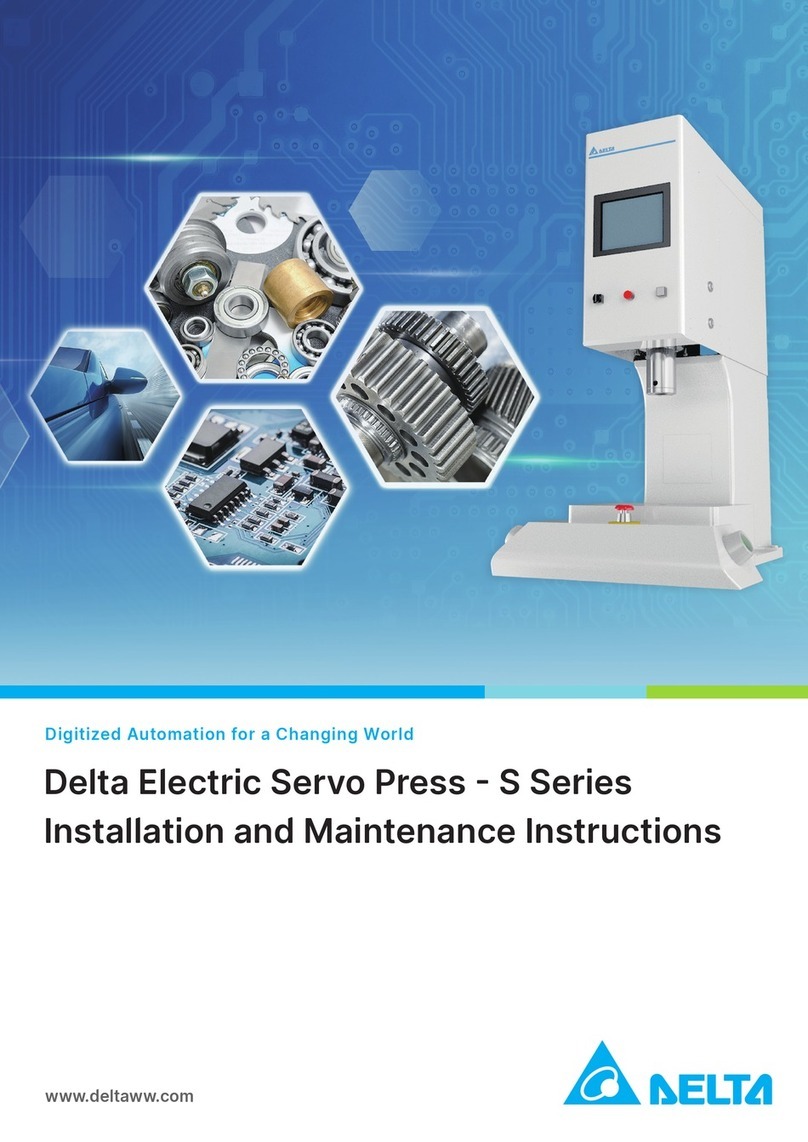
Delta
Delta S Series User manual
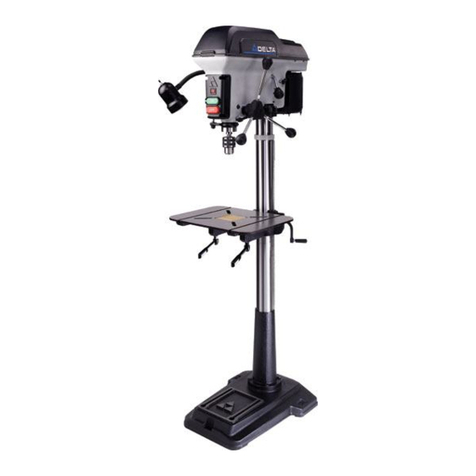
Delta
Delta 17-959L User manual
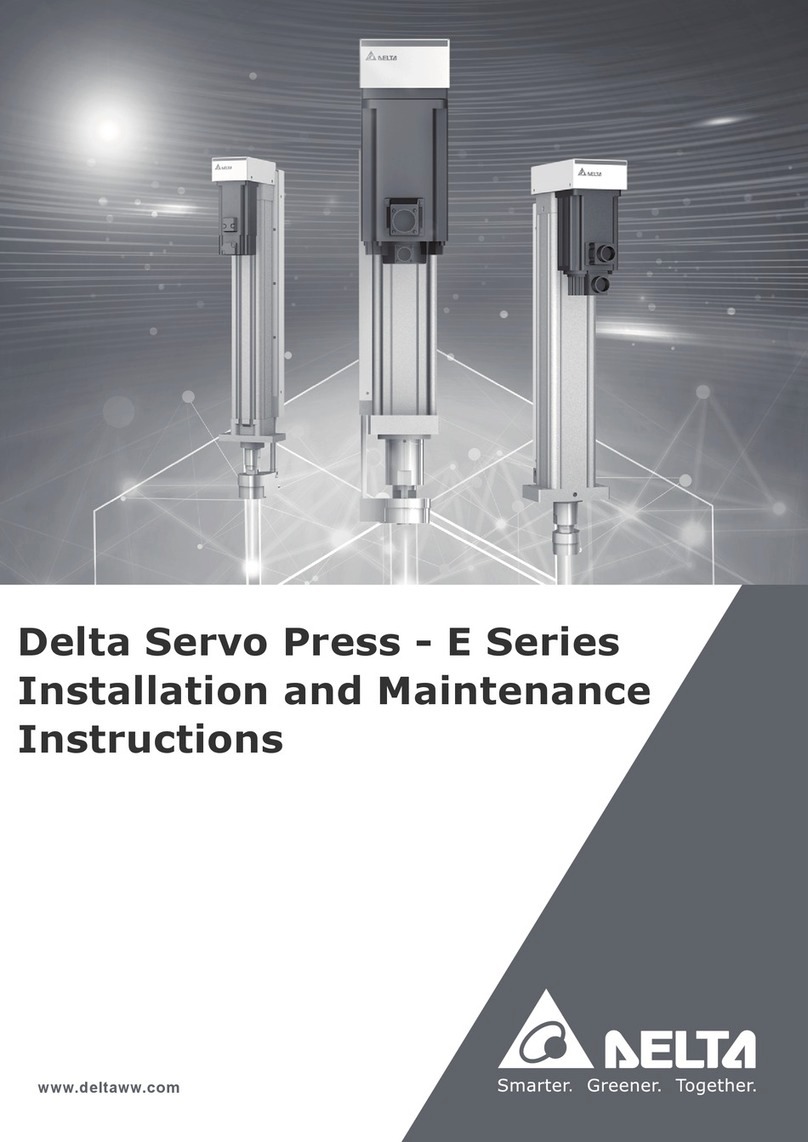
Delta
Delta E Series User manual
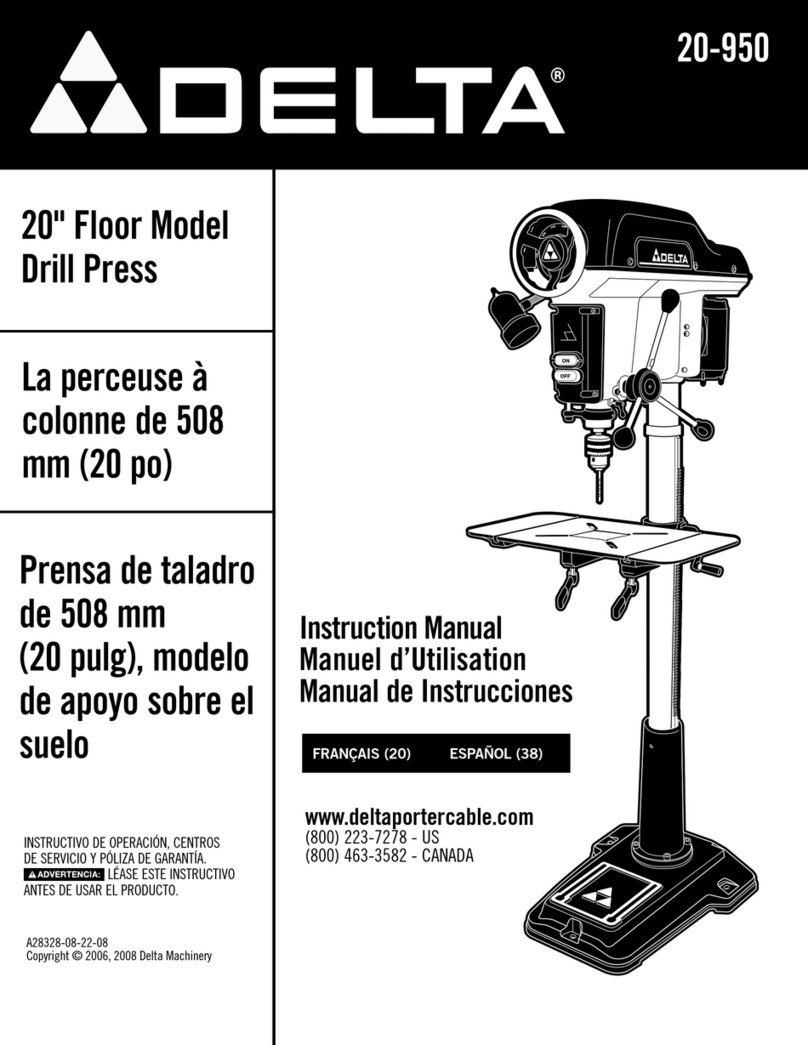
Delta
Delta 20-950 User manual
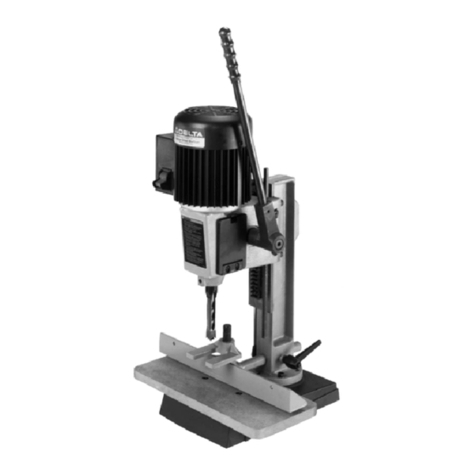
Delta
Delta 14-650 User manual

Delta
Delta Delta JT360 User manual
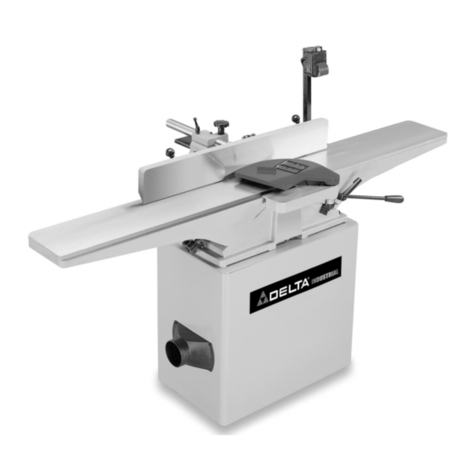
Delta
Delta 37-380 User manual
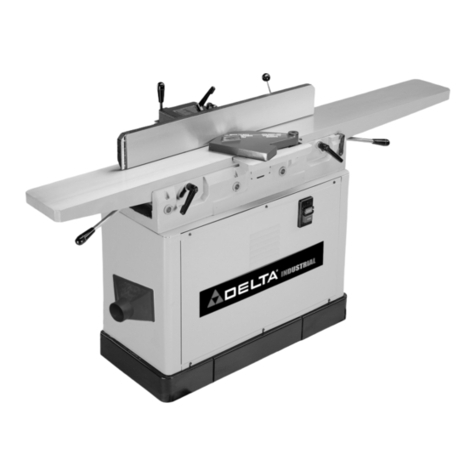
Delta
Delta DJ-20 Series User manual
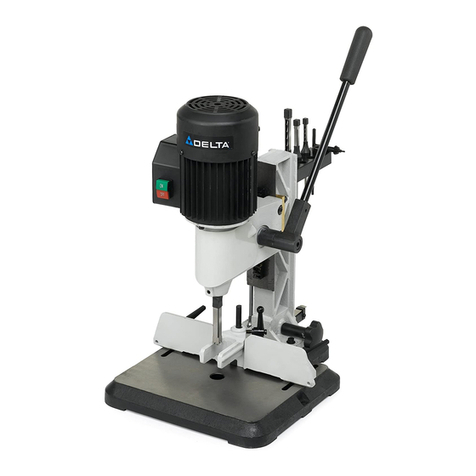
Delta
Delta 14-651 User manual
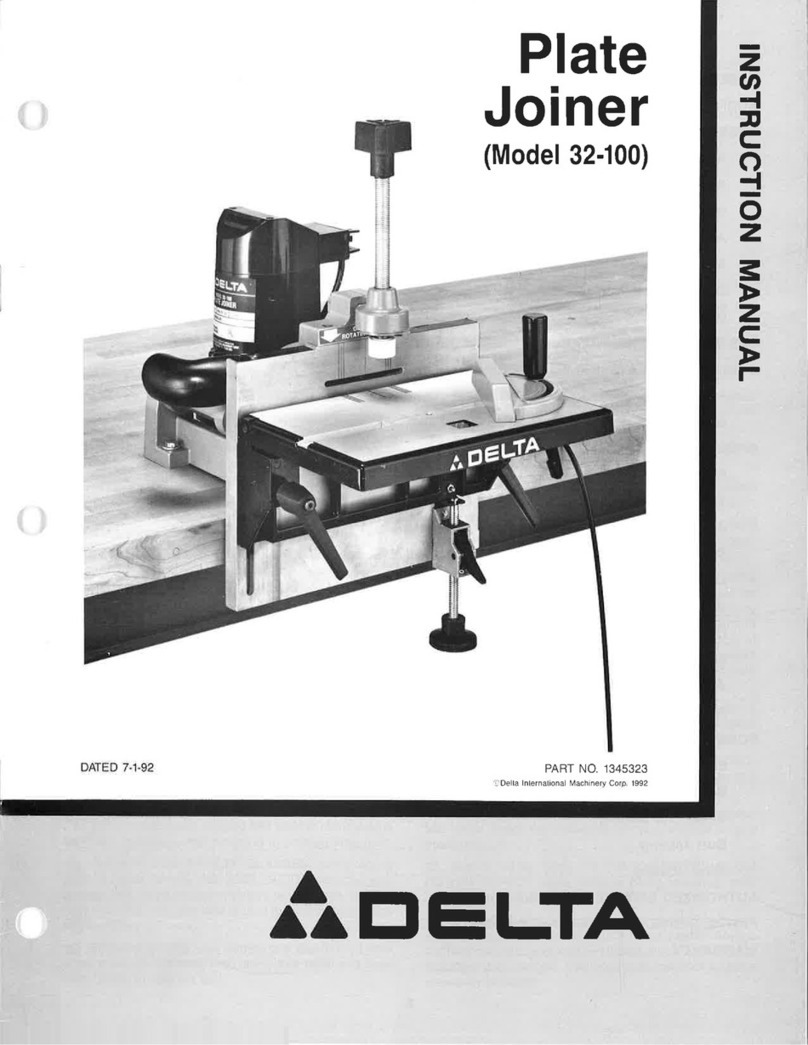
Delta
Delta 32-100 User manual
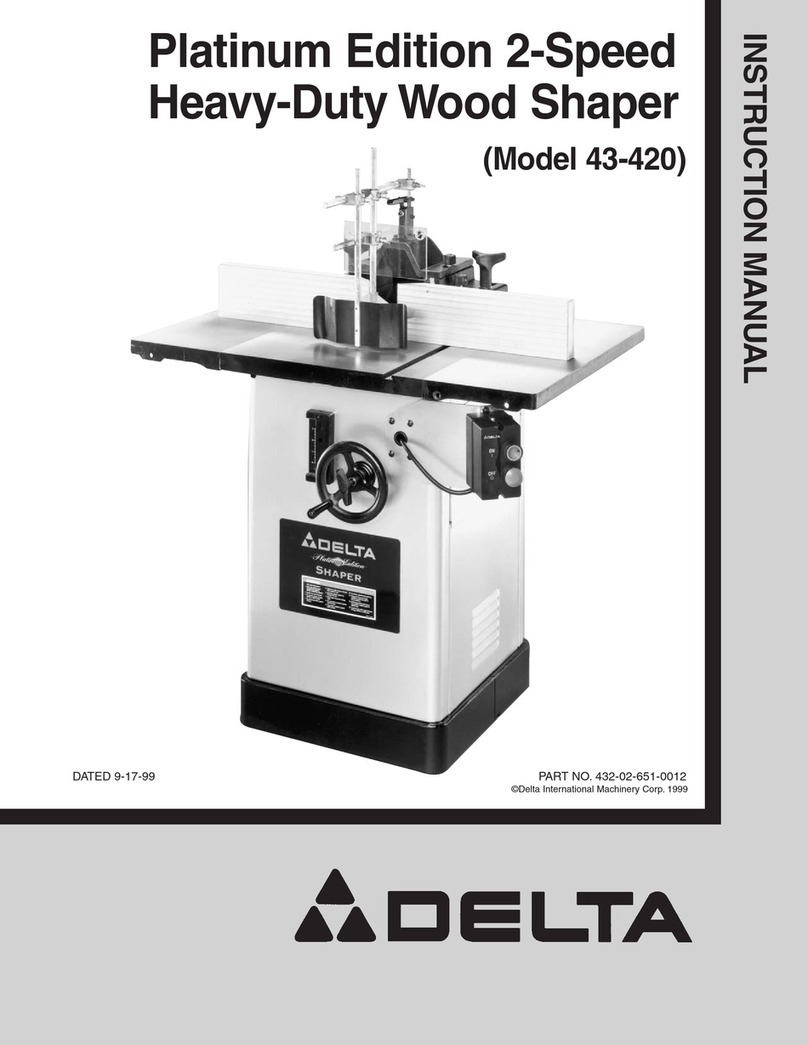
Delta
Delta Platinum Edition 43-420 User manual

Delta
Delta 37-280 User manual
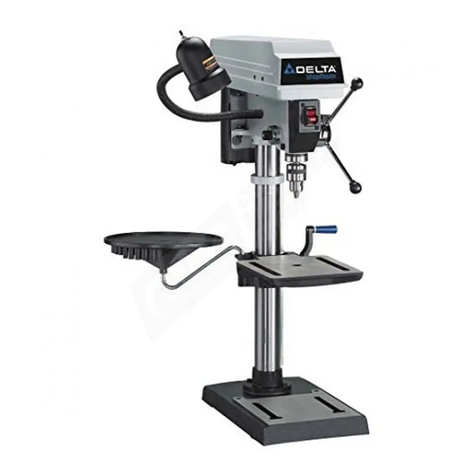
Delta
Delta DP300 User manual
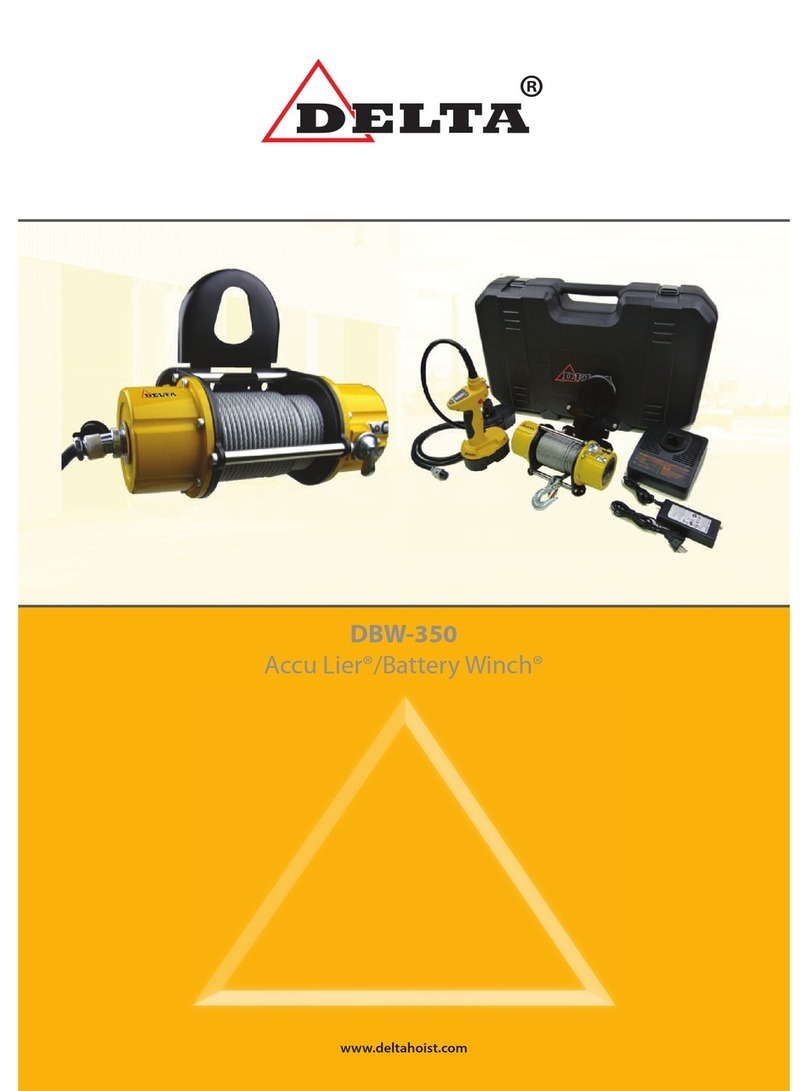
Delta
Delta DBW-350 User manual

Delta
Delta 43-435 User manual

Delta
Delta 32-326 User manual
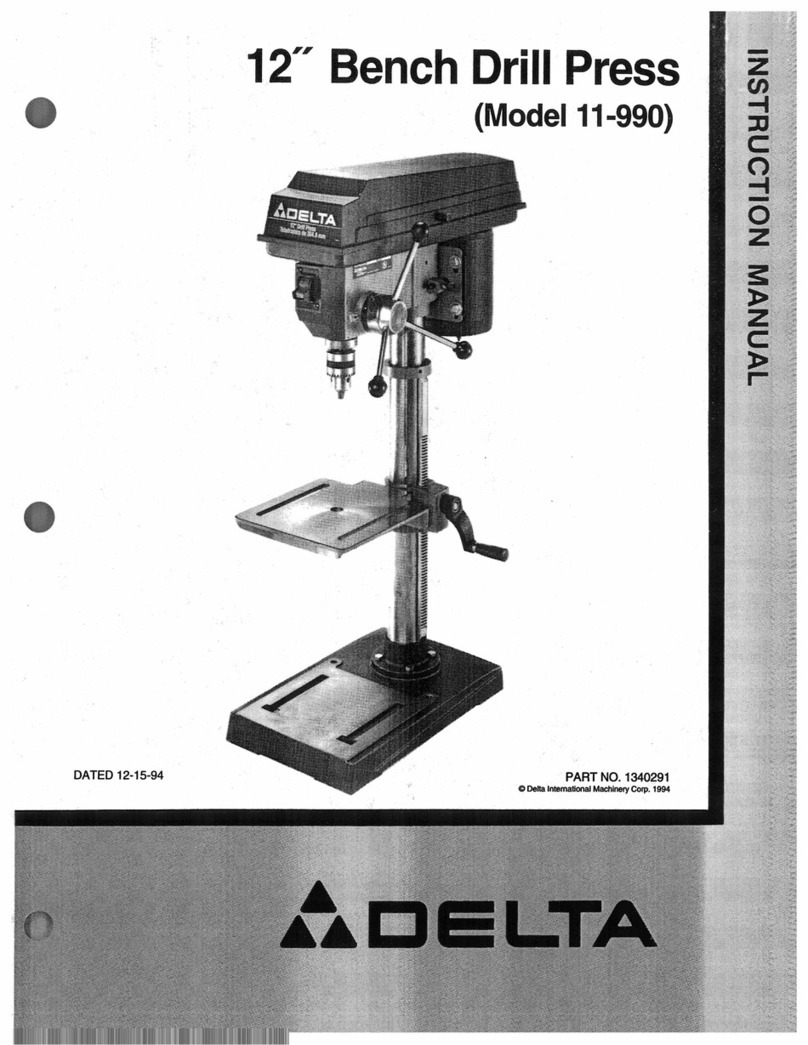
Delta
Delta 11-990 User manual
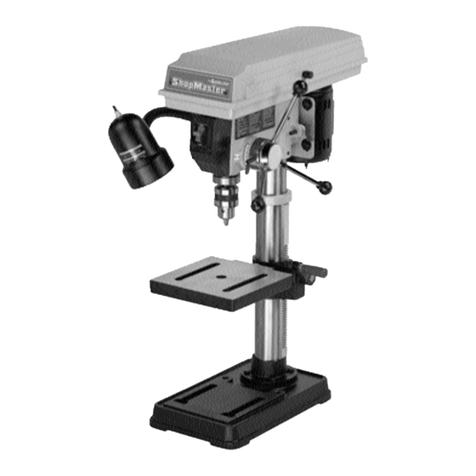
Delta
Delta ShopMaster 638517-00 User manual
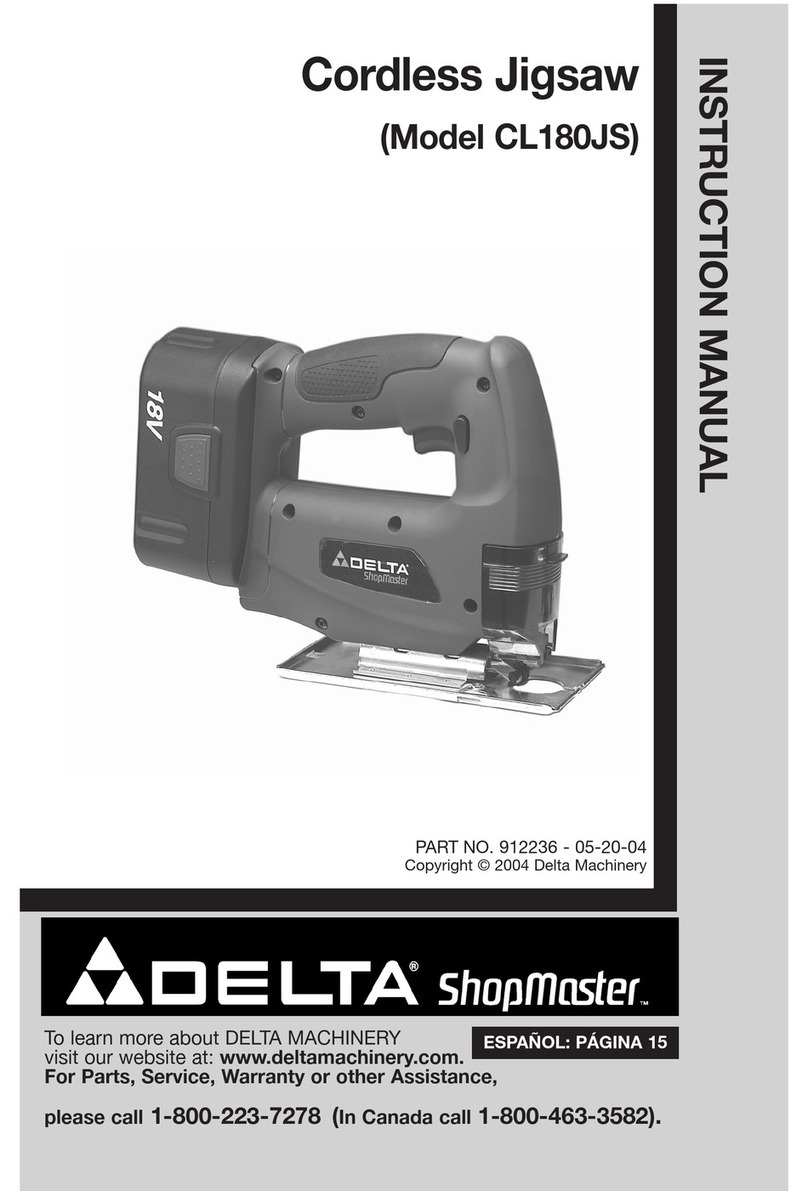
Delta
Delta ShopMaster CL180JS User manual
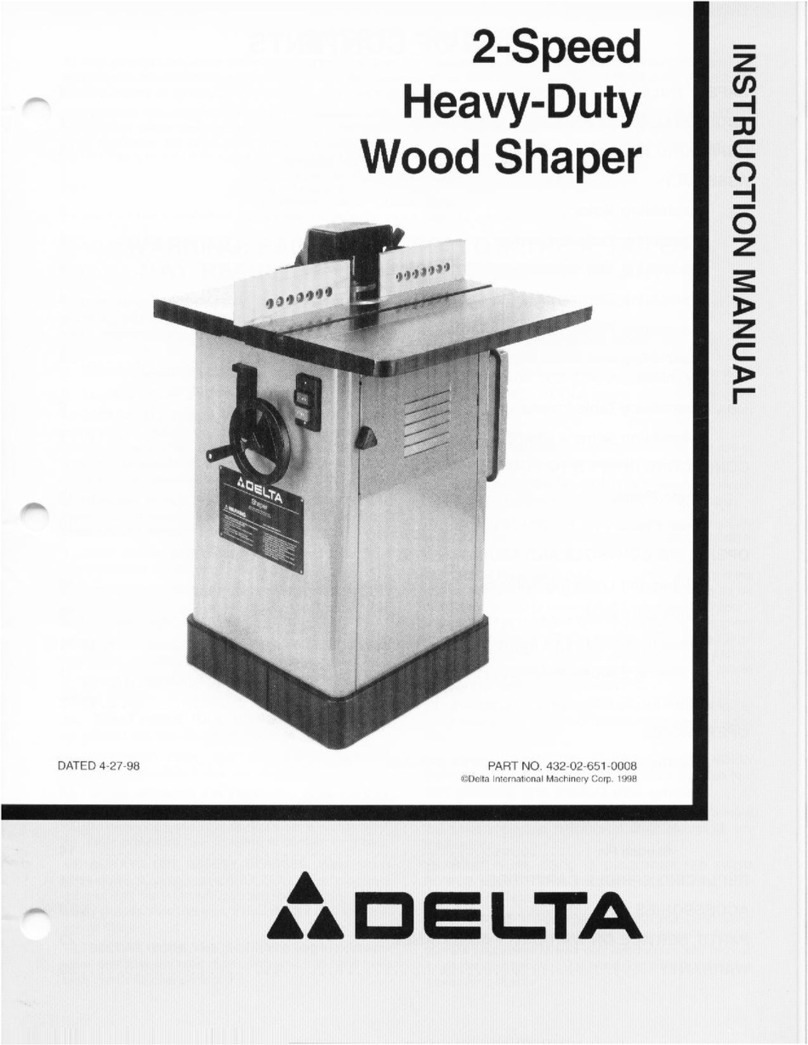
Delta
Delta 2-speed heavy-duty wood shaper User manual
